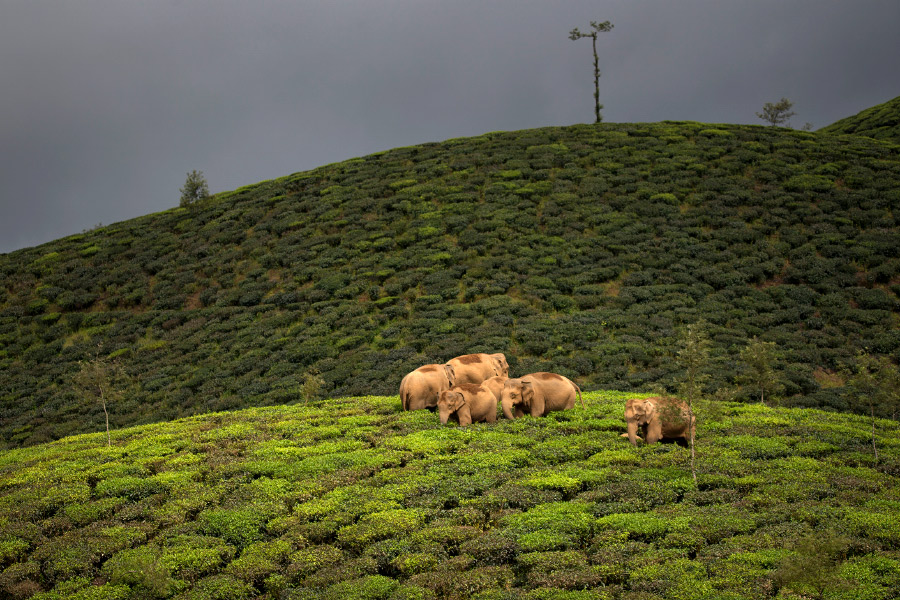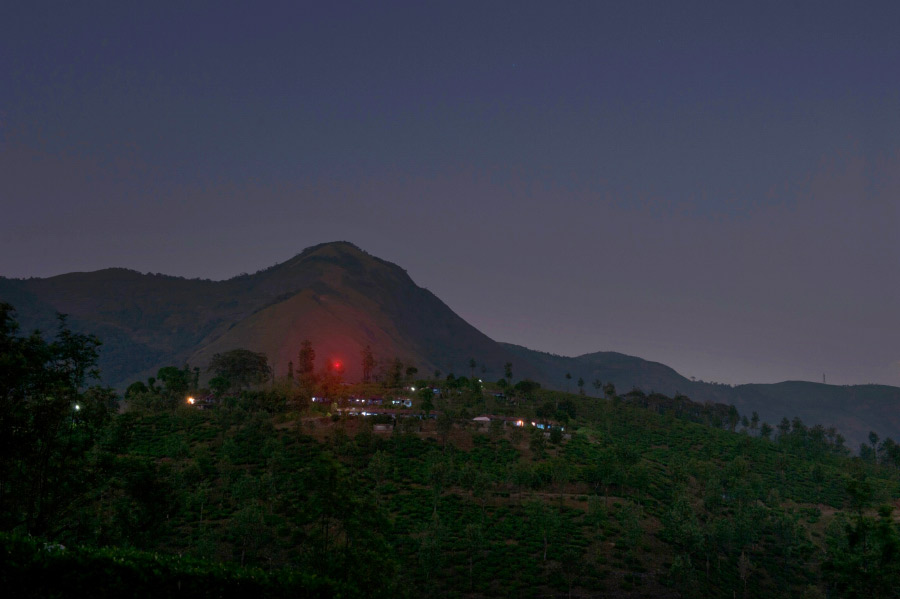Understanding human-elephant interactions is critical for conservation of elephants outside Protected Areas. One of the intriguing questions is how can a person weighing 50kg and a 5000kg animal coexist with no barrier between them?
Conflict incidents frequently lead to use of reactive measures such as chasing elephants, capture and translocation, or retaliatory persecution, but these often fail to resolve conflicts on a sustained basis, empower communities to implement solutions, or help conservation of elephants. Long-term research on behavioural and ecological aspects and human-elephant interactions is needed to better understand conflicts and identify appropriate solutions.
Our long-term work over a decade from the Valparai plateau, a landscape matrix of tea, coffee, and rainforest fragments in the Anamalai hills, Tamil Nadu to showcase where elephants and people could maintain permeable spaces with simple but participative measures. By tackling elephant herds and individuals to understand their movement patterns, preferred habitats, spatial and temporal conflict occurrence enabled us to identify and implement targeted mitigation efforts. The major conflict concerns were the safety of human life and damage to buildings where food grains are stored. Our studies revealed that lack of information about elephant presence and movement through plantations was the major reason for loss of human life, suggesting a need for early intimation about elephants. We have initiated early warning systems in a phased manner by using local TV network as a source of intimating people about elephant locations and warn them to avoid direct encounters. This had resulted in decline in human fatal incidents over years with no incidences of human death noticed for 32 month period between 2004 – 2007. This has prompted us to implement systematic advanced intimation systems with a team of dedicated conservation scientists in the following ways.
Implementation of early warning measures
Since 2011, the Nature Conservation Foundation (NCF) in collaboration and partnership with Elephant Family, Whitley Fund for Nature, Rufford Foundation, PBNF, and TamilNadu State Forest Department, and cooperation from the Anamalai Plantation Companies has implemented early warning systems to develop an effective Elephant Information Network (EIN) in the Valparai region. The early warning systems are simple, adoptive, and participative which helped increase tolerance levels of people towards elephants while imparting sense of responsibility in the management of human–elephant conflict. This is also followed by Forest Department new initiatives in the following ways:
- Television network: Elephant information location details obtained from daily tracking of elephants in plantations and information from Forest Department field staff and local people is displayed as a ‘crawl’ on local cable TV channel after 5 PM everyday to reach out to people as an early elephant intimation system. Currently, the cable channel covers nearly 5,000 families on the Valparai plateau.
- Bulk SMS service: Bulk SMS service has been implemented to send out text messages about elephant presence and their movements within plantations to people who are willing to receive information on their mobile phones. On a daily basis, on average 700 messages/day are being sent in English and Tamil to people residing within a 2 km radius of the location of elephant herds. The 2 km radius was chosen based on the high likelihood (> 80%) that elephants would move within that distance over a 24-hour period. There are 4200 people/families who have who opted voluntarily and registered for SMS facility to receive elephant messages on the Valparai plateau. An analysis of people’s response calls to the SMS initiative reveals that this measure has been extremely helpful and serves as a timely alert to the presence of elephants, allowing people to take adequate precautions to avoid direct encounters with elephants and safeguard property.
- Installation of elephant alert indicators: Mobile operated LED-light alert indicators were installed in 24 locations to signal the presence of elephants and their movements within a 1km radius of each light. These indicators are equipped with a SIM card and fitted with red flashing LED bulbs on a 10m long pole and are located in strategic places that are visible from up to 1km away. Each light can be operated from any of three registered mobile phones. At least two mobile phone numbers of identified persons from every “light locality” are registered with each light. These persons are responsible for activating these lights when elephants were noticed within 1km radius from light location. During the last three years, on an average, after the initial month of installation and training, the local community itself operated the lights 98% of the time. Number of false alarms or failed operations were less than one percent of total number of light days during which people could potential operated lights.
By reviewing these measures and responses from stakeholders, we have identified certain gaps in our measures which would require strengthening and expanding early warning systems with new initiatives as described below.
- Outbound Voice call service: This system broadcast recorded elephant alert messages in MP3 files and uploaded using web interface to designated mobile numbers of people who reside in close quarters of elephant locations. This message is helpful for people who could not read text messages on their phones and bring close attention of recipient to elephant alerts. On daily basis, during the past one year we have sent out an average of 1000 calls per day to people who had opted this service.
- Bus broad cast systems: We have installed six automated bus announcement systems in plying on six routes. As a follow up on Government Order received in October 2015,we have installed in six buses plying on six different routes covering about 70% of the Valparai plateau. This system would be helpful for people who cannot read text messages, non-delivery of text or voice call alerts, if inbox of recipient’s mobile phone is full or for people may not own mobile phone, and school children who would take buses late in the evening after special classes in schools. To pick these students, parents have to walk down from their colonies to the bus stop during late in the evening which may pose potential danger to encounter elephants in the dark hours of the day. This system complement other initiatives to develop a strong elephant information network to avoid surprise encounters with elephants. On daily basis, voice announcements will be broadcasted between 5-10 pm at regular intervals in buses.
Based on these experiences and knowledge, we have recently expanded our programme to other critical landscapes which would represent most part of human-elephant interaction landscapes. These include forest-agriculture hard-edge interface of Sathyamangalam in Tamil Nadu and a complex coffee-paddy-forest mosaic of Hassan region in Karnataka to understand human-elephant interaction dynamics to explore the possibility of finding ways to address human-elephant conflict. Our experience indicates that a long-term science-based approach with sustained participation by local communities can help in positive conflict management, deliver direct benefits to problem locations, and increase people’s tolerance of elephants. It also suggests that a shift from the conventional, reactive ‘problem elephant’ approaches to a pro-active ‘problem location’ approach may be more effective to promote coexistence and elephant conservation in modified landscapes.
- Rapid Response Team and Helpline by the Tamil Nadu Forest Department: The Anamalai Tiger Reserve (ATR) has initiated Rapid Response Team which comprises of anti-poaching field staff in two ranges, namely Valparai and Manampally, covering the Valparai region. These teams will be positioned in critical conflict prone-areas based on the information about elephant locations on daily basis to safe guard human property and communicate elephant presence to local people. A helpline facility has been initiated in the Animal Disaster Management Centre at Rottikadai in the Valparai region for people to seek help from the Forest Department field staff in times of emergency. Additionally, there are voice based alert light systems installed in ten locations and sensor based elephant detectors placed in four critical elephant movement areas in tea fields. The above collective efforts resulted in reduced incidences of human deaths and damage to property by elephants.
Results
Systematic implementation of early warning systems resulted in gradual decline in human fatalities during the past three years with no incident of death or injury noticed in 2013. Average number of human deaths reduced from three persons per year between 1994 – 2002 (prior to our research) to 1 person year between 2003 – 2016. And also there may have been many people who would have taken adequate precautions due to alerts and avoided direct encounters with elephants.
There is a need to strengthen sensitization of people through awareness programmes to make these efforts sustainable and further reduction in conflict incidents in future. Positive results were also visible in terms of reduction in property damage incidents by elephants where incidences of property damage declined by more than 50% over years. We believe that these systems may be helpful in other similar landscapes such as Gudulur region in Tamil Nadu, some parts of West Bengal and Assam in which high incidences of loss of human life and injuries have been witnessed.



 CI is a non-profit, non-commercial portal that aims to facilitate wildlife and nature conservation by providing reliable information and the tools needed to campaign effectively.
CI is a non-profit, non-commercial portal that aims to facilitate wildlife and nature conservation by providing reliable information and the tools needed to campaign effectively.